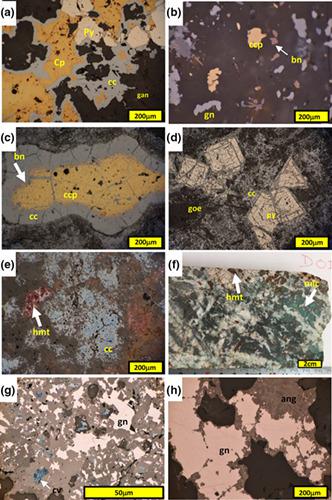当前位置:
X-MOL 学术
›
Resour. Geol.
›
论文详情
Our official English website, www.x-mol.net, welcomes your feedback! (Note: you will need to create a separate account there.)
Geology, mineralogy, and sulfur isotopes of the Mowana copper deposit, Matsitama Schist Belt, NE Botswana
Resource Geology ( IF 1.4 ) Pub Date : 2021-06-23 , DOI: 10.1111/rge.12263 Amogelang Kooganne 1 , Akira Imai 2 , Andrea Agangi 1 , Ryohei Takahashi 1
Resource Geology ( IF 1.4 ) Pub Date : 2021-06-23 , DOI: 10.1111/rge.12263 Amogelang Kooganne 1 , Akira Imai 2 , Andrea Agangi 1 , Ryohei Takahashi 1
Affiliation

|
The Mowana hydrothermal Cu deposit is located within the Matsitama–Motloutse Complex in the southwestern part of the Zimbabwe Craton in the northeastern part of Botswana. This study aims to document the characteristics of the mineralization based on geology, quartz textures, ore mineralogy, chlorite geothermometry, and sulfur isotope analyses. The deposit is hosted by the NNE-striking and nearly vertically dipping (70–80°) Bushman Lineament, within the graphitic schist lenses in the carbonaceous and argillaceous metasedimentary rocks of the Neoarchean to Paleoproterozoic Matsitama Sedimentary Group. The hydrothermal alteration of the host rocks is characterized by silicification, chloritization, epidotization, sericitization, hematite, and calcite alteration. Based on the alteration mineral assemblage, the main mineralization stage is attributed to near neutral pH fluids at temperatures between ~200 and ~340°C. The base metal mineralization of the Mowana deposit was evolved in at least two vein types. The first mineralization type, represented by the quartz+calcite±K-feldspar veins and breccias is characterized by the precipitation of principal chalcopyrite with pyrite, minor bornite, and trace amounts of galena. The Type 2 veins represented by the quartz+calcite±fluorite veins, host appreciable amounts of galena. The supergene mineralization widely distributed in the shallow levels of the deposit is manifested by the significant presence of chalcocite, bornite, covellite, anglesite, malachite, and hematite. The temperature obtained from the chlorite geothermometry in the Type 1 veins indicate that the mineralization associated with chlorite alteration formed at a temperature ranging from 340 to 400°C. The ore mineral assemblage: pyrite, bornite, and chalcopyrite, paired with the chlorite geothermometry data indicate that the Type 1 veins formed at an intemediate to high sulfidation state. Sulfur isotopic ratios determined on the sulfides indicate the magmatic S and/or leaching of the host metasedimentary rocks and closed system reduction of seawater sulfate as the sources of S.
中文翻译:

博茨瓦纳东北部 Matsitama 片岩带 Mowana 铜矿床的地质学、矿物学和硫同位素
Mowana 热液铜矿床位于博茨瓦纳东北部津巴布韦克拉通西南部的 Matsitama-Motloutse 杂岩内。本研究旨在根据地质学、石英结构、矿石矿物学、绿泥石地球测温法和硫同位素分析记录成矿特征。该矿床位于新太古代至古元古代 Matsitama 沉积群的碳质和泥质变沉积岩中的石墨片岩透镜体中,呈 NNE 走向且几乎垂直倾斜 (70-80°) 布须曼线。母岩热液蚀变具有硅化、绿泥石化、绿帘石化、绢云母化、赤铁矿、方解石化等特征。根据蚀变矿物组合,主要的矿化阶段归因于温度在 ~200 到 ~340°C 之间的接近中性 pH 值的流体。Mowana 矿床的贱金属矿化至少演化为两种矿脉类型。以石英+方解石±钾长石脉和角砾岩为代表的第一种矿化类型,以主要黄铜矿与黄铁矿、次要斑铜矿和微量方铅矿的沉淀为特征。以石英 + 方解石±萤石矿脉为代表的 2 型矿脉含有大量方铅矿。表生矿化广泛分布于矿床浅层,显着存在辉铜矿、斑铜矿、铜钴矿、角铁矿、孔雀石和赤铁矿。从 1 类矿脉中的绿泥石地质测温获得的温度表明,与绿泥石蚀变相关的矿化形成于 340 至 400°C 的温度范围内。矿石矿物组合:黄铁矿、斑铜矿和黄铜矿,结合绿泥石地质测温数据表明,1 型矿脉形成于中高硫化状态。硫化物上测定的硫同位素比表明岩浆 S 和/或宿主变质沉积岩的浸出和海水硫酸盐的封闭系统还原作为 S 的来源。
更新日期:2021-06-23
中文翻译:

博茨瓦纳东北部 Matsitama 片岩带 Mowana 铜矿床的地质学、矿物学和硫同位素
Mowana 热液铜矿床位于博茨瓦纳东北部津巴布韦克拉通西南部的 Matsitama-Motloutse 杂岩内。本研究旨在根据地质学、石英结构、矿石矿物学、绿泥石地球测温法和硫同位素分析记录成矿特征。该矿床位于新太古代至古元古代 Matsitama 沉积群的碳质和泥质变沉积岩中的石墨片岩透镜体中,呈 NNE 走向且几乎垂直倾斜 (70-80°) 布须曼线。母岩热液蚀变具有硅化、绿泥石化、绿帘石化、绢云母化、赤铁矿、方解石化等特征。根据蚀变矿物组合,主要的矿化阶段归因于温度在 ~200 到 ~340°C 之间的接近中性 pH 值的流体。Mowana 矿床的贱金属矿化至少演化为两种矿脉类型。以石英+方解石±钾长石脉和角砾岩为代表的第一种矿化类型,以主要黄铜矿与黄铁矿、次要斑铜矿和微量方铅矿的沉淀为特征。以石英 + 方解石±萤石矿脉为代表的 2 型矿脉含有大量方铅矿。表生矿化广泛分布于矿床浅层,显着存在辉铜矿、斑铜矿、铜钴矿、角铁矿、孔雀石和赤铁矿。从 1 类矿脉中的绿泥石地质测温获得的温度表明,与绿泥石蚀变相关的矿化形成于 340 至 400°C 的温度范围内。矿石矿物组合:黄铁矿、斑铜矿和黄铜矿,结合绿泥石地质测温数据表明,1 型矿脉形成于中高硫化状态。硫化物上测定的硫同位素比表明岩浆 S 和/或宿主变质沉积岩的浸出和海水硫酸盐的封闭系统还原作为 S 的来源。



























 京公网安备 11010802027423号
京公网安备 11010802027423号